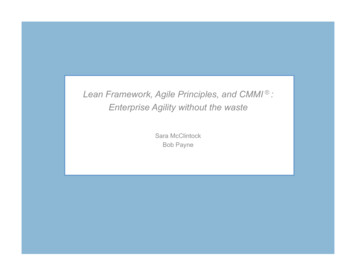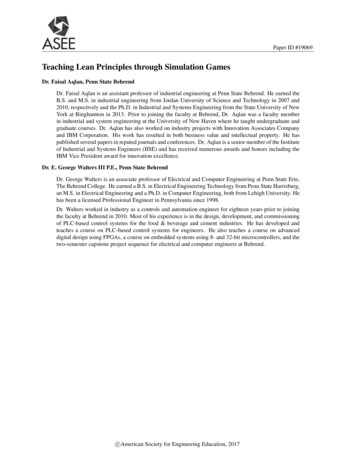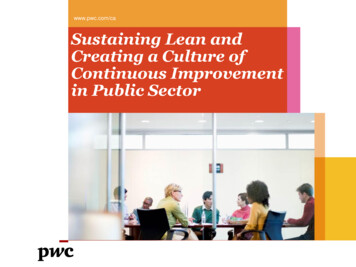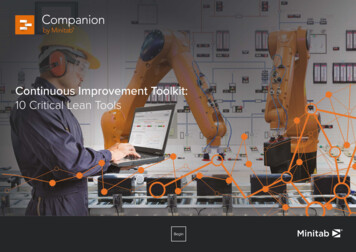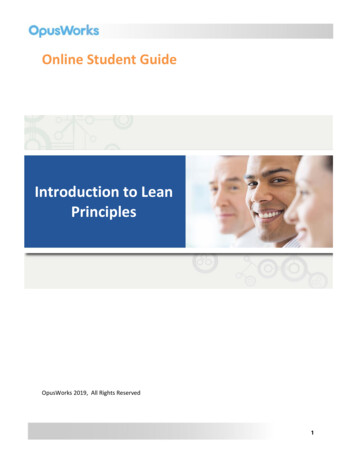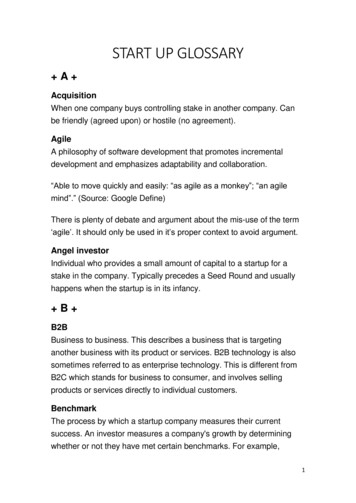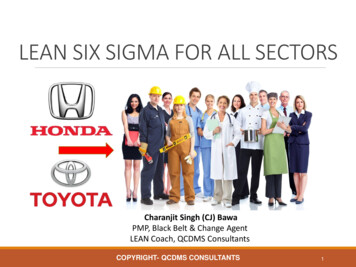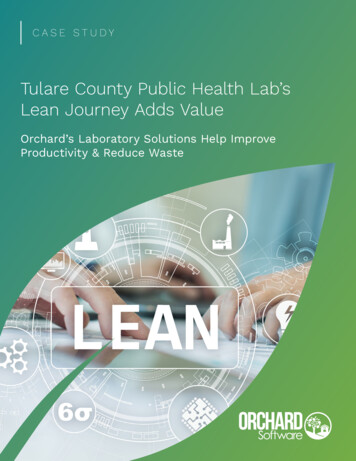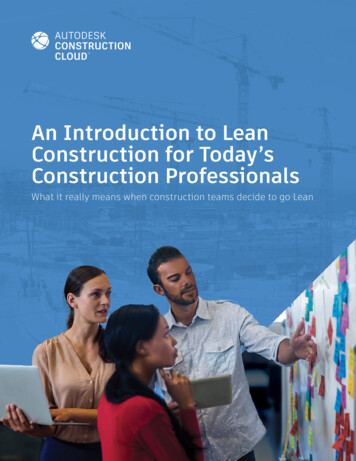
Transcription
An Introduction to LeanConstruction for Today’sConstruction ProfessionalsWhat it really means when construction teams decide to go Lean
The Ultimate Guide to Lean Construction for Today’s Construction ProfessionalsWhat’s Inside?4Introduction6Productivity Has FlatlinedThe Problem Can Be Solved7The History of LeanModern Usage of Lean in Manufacturing8Five Principles of LeanPrinciple 1 - Define ValuePrinciple 2 - Map the Value StreamPrinciple 3 - Create FlowPrinciple 4 - Establish PullPrinciple 5 - Pursue Perfection10 Leveraging Lean Principles in ConstructionLean Construction is DifferentIntegrated Project Delivery14 The Benefits of Building LeanImproves Work Quality16 Modern Tools Facilitate Lean Construction18 Conclusions23
The Ultimate Guide to Lean Construction for Today’s Construction ProfessionalsIntroductionIf you attend a conference or participate in professional development related toproductivity in the construction industry, you will surely hear Lean Constructioncome up. It’s become a popular buzzword in reference to the many different waysto boost productivity on a construction site–but what does it really mean?Lean Construction is the application of Lean production management andmanufacturing practices to construction project delivery. This includes theentire construction industry (owners, designers, architects, engineers, generalcontractors, subcontractors and end users) and not simply the work that occursduring the construction portion of a project. In the 80s and early 90s, Leanproduction techniques changed the efficiency and profitability of manufacturingacross the world. These techniques are now enthusiastically being appliedby progressive teams to a broad range of industries ranging from healthcare,services, retail and more."It’s estimated that constructionteams in the US will lose 177billion in non-productive laboractivities. The loss includes lookingfor project data and information,conflict resolution and dealing withmistakes and rework."Today’s construction professionals are looking for ways to maximize value andefficiency and minimize waste, essentially doing more with less. Applying LeanConstruction management principles to a project and continuously assessingways to eliminate waste and inefficiencies achieves:4 Increased productivity Reduces waste Enhanced quality Advanced execution–less fire-fighting Improved operations–smoother flows Reduced operating costs5
The Ultimate Guide to Lean Construction for Today’s Construction ProfessionalsProductivityHas FlatlinedProductivity improvements in the construction industry has flatlined inrecent decades compared to other industries like information technology,manufacturing and agriculture. From PlanGrid and FMI’s report, “ConstructionDisconnected,” it’s estimated that construction teams in the US will lose 177billion in non-productive labor activities. The loss includes looking for projectdata and information, conflict resolution and dealing with mistakes and rework.Additionally, the report estimates that poor data and communication contributesto 31 billion in rework. With this level of waste across the globe, it’s no wonderthat many organizations are looking for ways to positively impact productivityand ultimately their bottom line.This is a Problem That Can Be SolvedIf we assume that significantproductivity gains are possible inconstruction, then there must beopportunities for improvement thatare not currently being addressed.Project owners are likely overpayingfor projects due to poor productivityand general contractors sufferingfrom increasingly low profit marginsdue to inefficiencies. What should bemost alarming is that many industry6professionals don’tperceive that there is a need for achange or acknowledge that there iseven a problem.Nonetheless, looking at how Leanprinciples have revolutionizedproductivity in industries such asmanufacturing, construction teamscan begin to understand how LeanConstruction is a framework that canboost efficiency and profits.1The History of LeanThe first person to begin really streamlining the production process was Henry Fordin the early 1900s.2 In 1913, he pioneered what he called flow production, which waslater referred to by the public as the moving assembly line. Ford was the first to lineup fabrication steps in a process sequence to better fabricate and assemble thecomponents of a vehicle in a matter of minutes. This was a revolutionary change incontrast to practices of the time where general purpose machines were simply groupedby process.Modern Usage of Lean inManufacturingThe term Lean was first used todescribe the production principlesapplied in automobile manufacturing.It was coined by John F. Krafcikto describe a production policyhe observed at automotivemanufacturing plants. The plantswere able to produce a wide rangeof models, while still maintainingthe highest levels of productivityand quality.Krafcik asserted that the use oftechnology did not yield the desiredimpacts on quality and productivity ifit’s applied without proper productionmanagement policies. Krafcik definedthe key policies applied at themost productive plants, which havebecome the basis for Lean productionprinciples and the last 30 years ofLean studies:3 Workflow standardization removingwaste Decentralized process improvementresponsibilities–workers as morethan cogs in a machine adaptabilityand flexibility towards improvements Just-in-time inventorysystem remove waste High emphasis onteamwork respect, mutualtrust and peer developmentIn manufacturing, a team can analyzethe efficiency and productivity of aproduct over and over again untilthey are able to nearly perfect theprocess and the product’s quality.In construction, most aspects of aproject are essentially a prototype.There is no other previouslyassembled copy to refine that hasthe same conditions, same peopleand same process. Even so, thereare still many lessons and principlesfrom Lean manufacturing that can beapplied to construction in an effort toachieve higher levels of productivityand quality.7
The Ultimate Guide to Lean Construction for Today’s Construction ProfessionalsFive Principles of LeanThe Five Principles of Lean originate from a book titled “The Machine That Changed TheWorld.” This includes defining value, mapping the value stream, creating flow, using a pullsystem and pursuing perfection. The goal of these five principles is to encourage creating abetter flow in work processes and developing a continuous improvement culture.Principle 1 - Define ValueThe first Lean principle defines valueas the customer’s needs for a product.It is vital to fully understand yourcustomer’s needs. By using qualitativeand quantitative techniques(interviews, demographic information,web surveys, etc.) you can uncoverwhat customers want, how they wantit and the price they’re willing to pay.4Principle 2 - Map the Value StreamIdentifying and mapping the valuestream is the second principle of Lean.The goal of this principle is to use thecustomer’s value as a reference point8to identify all activities required totake a project from raw materials tothe final delivered product. Activitiesthat do not add value to the customerare considered waste. Waste can bebroken into two categories: nonvalue added but necessary andnon-value added and unnecessary.Non-value added and unnecessaryactivities are pure waste and shouldbe eliminated. Non-value added butnecessary should be reduced as muchas possible. Reducing and eliminatingwaste ensures that customers aregetting exactly what they want forthe lowest possible cost.4Principle 3 - Create FlowThe third principle of Lean is creatingflow. Once waste has been removedfrom the value stream, it’s importantthat the remaining steps flowsmoothly without delay or bottlenecks.Strategies to achieve this includebreaking down steps, reconfiguringproduction processes, leveling out theworkload, creating cross-functionalteams and training.4If your flow is improved, the timerequired to deliver to the customer isalso improved. A pull-based systemallows for just-in-time delivery andmanufacturing where materialsare delivered in only the necessaryquantities and work is completed atexactly the right time for the nextstep in the process to begin. A pullbased system is driven directly by thePrinciple 4 - Establish PullEstablishing pull is the fourth principleof Lean. In a pull-based system, thegoal is to manage inventory and inprogress work items to ensure that thematerials and information needed fora smooth flow of work are available.Principle 5 - Pursue PerfectionThe first four Lean principles preventwaste, but the fifth step of pursuingperfection may be the most importantstep. Pursuing perfection meansmaking the Lean principles andprocess improvements a part of yourcompany culture. This empowers yourentire team to strive for perfectionand deliver exactly what yourcustomer needs.4needs of your customers.49
The Ultimate Guide to Lean Construction for Today’s Construction ProfessionalsLeveraging LeanPrinciples in ConstructionIn order to make Lean work for your organization, it’s important to remember that thisis a long term strategy. It makes much more sense to apply Lean techniques globallyinstead of on a project by project basis. Your employees will learn the benefits of Leanover time, making the techniques easier to apply on future projects. More importantly,concepts like waste reduction need to occur on an ongoing basis and your employeeswill further improve when they are empowered to act on Lean principles.Lean Construction is DifferentWhen contrasting how Lean is appliedin manufacturing versus construction,it’s easy to recognize how differenta construction project is from themajority of manufacturing plants. Inmanufacturing, a team can analyzethe efficiency and productivity ofa product until they are able toperfect the process and quality. Inconstruction, each project is differentand the lessons learned today maynot apply to the next project downthe road.Today’s typical construction modelsutilize the mass production mindset.This means that every job is allocatedto just one group with little or nointeraction between stakeholders(owners, architects, generalcontractors, subcontractors, etc.).10The siloing of work goes againstall the Lean Construction guidingprinciples. The lack of predictabilityis the crux of the typicalconstruction model. Unpredictabilityresults in lost time, waste andstress. Lean Construction is focusedon predictability and flow, thuseliminating most negative aspectsfrom the typical construction model.5Lean Construction forces all partiesto have clear goals, benchmarksand objectives from end to endof the construction process. Leanphilosophy ensures the team ismaximizing performance at everylevel, focused on the goals of thecustomer. The silo effect of thetraditional construction model iseliminated, forcing everyone on theproject to collaborate as a singlecustomer-focused group.5Integrated Project DeliveryTo defeat the silo effect in typicalconstruction models, a new projectdelivery method has started tobecome popular called IntegratedProject Delivery (IPD). IPD is a costand profit sharing delivery methodthat eliminates typical contractbarriers and incentivizes all teammembers to make “project” decisionsrather than “trade” decisions.6IPD allows you to create miniorganizations that last for thelength of a single project to powerthat project to success. When youbypass the traditional methods ofrunning a project, you can streamlineit. IPD is uniquely suited to putLean Construction principles intopractice because it has solved thecontractual issues that prevent truecollaboration–empowering teammembers in the sharing of ideas,materials and manpower.The main goal of Integrated ProjectDelivery is to create a team that canwork together well enough to powerthe project for success. This teamworks together for the length of theproject and may include membersfrom a variety of disciplines includingowners, contractors, subcontractors,architects and others.Note: An effective Lean strategyto implement is holding daily pullplanning huddles. Get your teamtogether each morning for a 6 minutehuddle where all the trades cometogether and update their items on thepull plan. This also gives them a forumto formally hand off work and ask forhelp when necessary.For step by step instructions on how toget your team set up for IPD, see theAmerican Institute of Architect’s officialguide titled “Integrated Project Delivery:A Guide.”Last Planner System and IPDOne of the key tools of Lean is the LastPlanner System (LPS) (also known asPull Planning), which is a work planmethod that is based on the following:1. Creating a backlog of tasks that areready for execution (make-ready)2. Committing on tasks that will beachieved in the next sprint–weeklywork plan (e.g., one week, twoweeks, three weeks, etc.)3. Reviewing and assessing thesuccess of those commitments–track progress, remedy issues,feedback and learningsWhen implementing the Last PlannerSystem, detailed knowledge of exactlywhere your team is at every stage ofthe project (progress tracking),and where they can execute mostproductively in the next sprint (lookaheads) is required.11
The Ultimate Guide to Lean Construction for Today’s Construction ProfessionalsWhen a team can closely monitortheir progress against the plannedcommitments, it allows decisionmakers to identify potentialupcoming risks and work towardsmitigating or eliminating them beforethey occur. This process is verydifferent from the status-quo, wherethe people that are able to makecourse-correcting decisions are thelast to know when a commitment orplan isn’t progressing as expected. Intraditional methods of planning, theproject manager or superintendentsfrequently find themselves reacting tofires and inefficiencies after they’veimpacted the project, rather thanhaving the opportunity to eliminateproblems proactively.Industry expert Michael Carr breaksdown and defines the five steps of TheLast Planner System as7:Master SchedulingTeams should begin building theirmaster schedule as soon as possible.All work will be based on thisschedule, so it’s vital to complete itearly. Master scheduling is the processteams use to schedule a project fromstart to finish. It’s important that thefull project is captured, with earlyphases being well defined from theonset of the project.7Phase SchedulingPhase scheduling is a collaborativeplanning and sequencing of tasksto complete the phases of workdefined in the master schedule. This12is typically accomplished with PullPlanning as a team where they workbackwards from clearly definedmilestones and identify all tasksin detail required to complete themilestone with satisfactory handoffsoccurring between tasks.7Look Ahead PlanningDuring look ahead planning, teamsidentify clear constraints that willprevent upcoming work from beingcompleted as planned. The goal isto mitigate these constraints beforethey become a problem to the project.Ideally this is occuring four to sixweeks out to best prevent problemsfrom occurring.7Commitment PlanningOn a weekly basis, teams shouldmeet to discuss current and futurework in progress. The goal shouldbe to commit to the approach toachieve completion of all work forthe upcoming week. It’s importantto meet on a weekly basis, with dailyhuddles in place to fully support theweekly meeting.7LearningOne of the most crucial points ofLean and Last Planner is learning.Teams must continually improveby taking notice of what went well(plusses) and what did not (deltas)and actionably managing theirprojects based on the successes andchallenges they’ve encountered.7For more detail on getting startedwith the Last Planner System, checkout the PlanGrid Blog “An Intro tothe Last Planner System” written byindustry expert Michael Carr.Prefabricated ConstructionSince Lean Construction leveragesprefabrication wherever possible,reduction in material waste isalso a great opportunity for gainsin profitability. More controlledproduction environments allowfor analyzing the materials andthe processes much closer andmaximizing the use of all rawmaterials. Minimizing the need forinventory and surplus materialsgenerates savings that can then beinvested back into the business.By using prefabrication, laserscanning and augmented reality–hospital owners are able to applyLean principles and modularize howthey fit out their new facilities. Teamscan take a kit-of-parts approach byleveraging 3D modeling to designrepeatable and reusable equipment,furniture, interiors, above-ceilingcomponents and in-wall components.These design features are created tobe reusable in any new facility, goingagainst the traditional ‘one off’ designprocess that most hospitals haveundergone in the past. By introducingthis level of repeatability, the costand design time for future hospitalfacilities decreases significantly. Thisstrategy is useful for any type ofowner that builds multiple facilitieswith similar design requirements.13
The Ultimate Guide to Lean Construction for Today’s Construction ProfessionalsThe Benefits ofBuilding LeanOne of the most important principles of Lean Construction is that when youoptimize a single step in a process, you de-optimize the rest. Traditionalconstruction contracts divide each team member on the project into separatesilos solely focused on optimizing their own part of the work, which de-optimizesthe whole.6Lean Construction principles help optimize the entire project by maximizing valueand minimizing waste by applying specific techniques to the project deliveryprocess. This results in: The project and its delivery process are designed together to better reveal andsupport the customer’s intent. Positive iteration within the process is supported whilenegative iteration is minimized. The work process is structured to maximize value and reduce waste at the projectdelivery level. Efforts to improve total project performance are amplified because it’s a moreimportant goal than reducing the cost or speed of one single activity. Control over the project is defined as “making things happen” instead of simply“monitoring the results,” with planning and control system performance beingmeasured and improved.Reliably managing work between specialists in design, supply and an assemblymeans value is delivered to the customer and waste is reduced. Lean Constructionprinciples are especially useful on complex, unclear and fast-track projects.These principles challenge the common belief that there will always be a tradeoffbetween time, cost and quality. When applying Lean Construction managementprinciples, the key benefits that can be achieved include:14Improves Work QualityLean principles and the integratedproject delivery process reliesheavily on trust and respect of allpeople involved, resulting in a higheremphasis on communication andteam performance. When a teamis working as a unit and not in thetraditional adversarial way that hasexisted in the construction industry–every stakeholder feels empowered tohighlight areas where more value andquality can be obtained.Increases Employee Collaborationand AccountabilityLean Construction managementrelies heavily on the collaborationof the entire team. Managing aLean Construction project involvesempowering all teams to contributeto the continuous improvementprocess through collaborativeproblem-solving.One way to achieve streamlined,open collaboration between allstakeholders on a project is byutilizing technology and softwarethat facilitates communication andproblem-solving.Boosts Project SatisfactionKnowing which aspects of a projectare regarded as the most valuableto the owner and end users allowsteams to make the best, quickestdecisions without jeopardizing theoutcome. When owners know thattheir best interest is at the core ofevery decision that is made on theproject, the speed at which issues areresolved in significantly increased.Decision making and contributions aredecentralized, which allow the projectto move quicker towards closeout.A project team that can promptlyresolve any blockers has a betterchance of staying on schedule andtracking to budget. All of these factorslead to a happy owner–and ultimatelyto more contracts, work and profit foreveryone involved.Increases ROICompanies have reported anincrease in productivity through theapplication of Lean Constructionmanagement principles to a project,translating to an increased returnon investment. Production rates arethe core measurement units that asubcontractor or any “producing”party on a project base their estimateson. Ultimately, meeting the productionrate used for an estimate is the keyto being profitable. Any increase inproductivity reduces the risk of losingprofit. Apart from the increase inproductivity, any reduction in waste–whether actual material waste orprocedural waste–results in overallefficiency of the project.15
The Ultimate Guide to Lean Construction for Today’s Construction ProfessionalsModern Tools FacilitateLean ConstructionThe good news is that software tools can help facilitate going Lean on yourprojects. The core of many construction software solutions (like AutodeskConstruction Cloud ) can help facilitate the level of collaboration needed forLean and IPD. When all members of the team can communicate, collaborate andcontribute with real-time information and access, many of the traditional problemsassociated with construction project management are drastically reduced."Today’s construction tools enableteams to focus on the Lean tenantof pursuing perfection by moreeasily facilitating continuousimprovement and learning."The right technology can help with project planning (scheduling, estimating,constructability), communication (bidding, meetings, etc.), document management(sheet management, shared documents), reporting (daily reports, asset tracking,time tracking), punch lists and facility management.8Using collaborative tools to enhance and overcome IT and communicationschallenges improves both efficiency and productivity. Data and documentationflow are improved, and workers on-site are better able to convey needs andconcerns to those in the office in real time. By facilitating this communication,construction brands can improve their customer experience and increase revenuesand profits.Today’s construction tools enable teams to focus on the Lean tenant of pursuingperfection by more easily facilitating continuous improvement and learning.Modern technology is one of the most strategic tools you can employ to createvalue and eliminate waste on your construction projects.91617
The Ultimate Guide to Lean Construction for Today’s Construction ProfessionalsConclusionsIt’s clear that the decision to implement practices like Lean Construction,Integrated Project Delivery or the Last Planner System should not be takenlightly. There are costs of time and money to consider and the rollout of any ofthese systems should be planned thoughtfully with participation from everyonethat will be impacted by the changes.Traditional construction practices have remained the same for many years, sogetting buy-in from your team may initially be a challenge. Consider a pilotproject to showcase how Lean can work for your organization, allowing youto build momentum and expand the program over time. During the pilot it’simportant to emphasize the benefits of Lean practices (greater project autonomy,less waste, clearer workflows, easier handoffs of completed work, etc.). This isan opportunity to show your team that going Lean will not make their jobs moredifficult and will ultimately give them a better platform for success.See the Future of Connected Constructionconstruction.autodesk.comIn 2018, Autodesk announced that construction would be a key focus area to help our customers on theirdesign and make journey. To capitalize on the opportunity, Construction became its own CEO-staff levelorganization, Autodesk Construction Solutions. This unique structure is comprised of product development,customer success, marketing, and field operations. The organization is designed to move at the speed of themarket and serve customers on a level playing field with other solution providers. Autodesk ConstructionSolutions offers products that cover the entire construction lifecycle, from design through plan to buildand operate, including the Autodesk Construction Cloud which brings together our cloud-based solutionsAssemble, BIM 360, BuildingConnected and PlanGrid.Our vision is to create a vibrant construction industry where predictability and productivity are exponentiallyincreased, while jobsite waste is proportionately reduced. The time has come for platform that will empoweran industry transformation. Our mission is to help construction teams meet the world’s rapidly expandingbuilding and infrastructure needs, while making construction more predictable, safe and sustainable.References[1]Resistance to Lean & Integrated Project Delivery Part I: Three Root Causes, Victor Ortiz, August 2017[2]A Brief History of Lean, Lean Enterprise Institute[3]5 Unexpected Benefits of Lean Construction Management, Rebeca Ayala, February 2018[4]The Five Principles of Lean, Doanh Do, August 2017[5]An Introduction to Lean Construction, Conrad Mackie[6]IPD & Lean Construction, Integrated Project Delivery Collective[7]An Intro to the Last Planner System, Michael Carr, June 2018[8]How Technology Enables a Lean Approach to Construction, Jennifer Suerth, February 2017[9]Software Enables Lean Construction Methodology, Constructiontech Staff, November 2015Autodesk and PlanGrid are registered trademarks or trademarks of Autodesk, Inc., and/or its subsidiariesand/or affiliates in the USA and/or other countries. All other brand names, product names, or trademarksbelong to their respective holders. Autodesk reserves the right to alter product and services offerings, andspecifications and pricing at any time without notice, and is not responsible for typographical or graphicalerrors that may appear in this document. 2019 Autodesk, Inc. All rights reserved.1819
With Autodesk software, you have thepower to Make Anything. The future ofmaking is here, bringing with it radicalchanges in the way things are designed,made, and used. It’s disrupting everyindustry: architecture, engineering,and construction; manufacturing;and media and entertainment. Withthe right knowledge and tools, thisdisruption is your opportunity. Oursoftware is used by everyone - fromdesign professionals, engineers andarchitects to digital artists, studentsand hobbyists. We constantly explorenew ways to integrate all dimensionsof diversity across our employees,customers, partners, and communities.Our ultimate goal is to expandopportunities for anyone to imagine,design, and make a better world.Connect with ACS 2020 Autodesk. All Rights Reserved.United States 1 (866) 475-3802construction.autodesk.comAustralia & APACAUS 61 1800 314 auUK & EMEA 44 808 1892 gb
Nonetheless, looking at how Lean principles have revolutionized productivity in industries such as manufacturing, construction teams can begin to understand how Lean Construction is a framework that can boost efficiency and profits.1 Modern Usage of Lean in Manufacturing The term Lean was first used to describe the production principles
